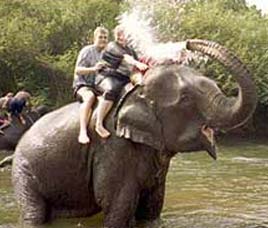Kaziranga National Park

The first and the oldest National Park in Assam situated in Golaghat District, is a World Heritage site. Spread over an area of 430 sq. kms., Kaziranga National Park is the natural home of the one-horned Indian rhinoceros (unicornis).
Situated about 217 km from Guwahati, capital of Assam, the world’s largest population of rhinoceros lives here. Although there are other animals and birds too but the concentration is more on the protection of this animal. In fact, Kaziranga can also be described as an oasis for wildlife.

Spread over an area of 430 sq km, the park is bounded by the mighty Brahmaputra on the north and verdant, hills of Karbi Anglong on the south. This park has no boundary wall and a rough oval shape. It lies on the south bank of Brahmaputra and its south side boundary follows (for the most part) the Mori Diffaloo river is close and to National Highway No. 37, the main arterial highway in Assam.

The world’s largest population of Indian one-horned rhinoceros (70 per cent). Wild buffalo (50 per cent) and swamp deer (65 per cent) are in the Kaziranga National Park.
Manas National Park

The only Tiger Project in Assam, Manas is one of India's most magnificent National Parks. It is situated on the bank of the river Manas at the foothills of the Himalayas. It is a well known World Heritage Site with it's unique combination of scenic beauty and rare wealth of wildlife.
Manas-Tiger
Covering an area of 519.77 Sq. Kms, it has a core area of 360 Kms and is situated in Barpeta District. Manas is one of the nine tiger reserve sanctuaries in India. Tigers however are not the only wildlife to be found here. Manas has its own peculiar faunal features, the rarest species of which are Hispid Hare, Pigmy Hog, Golden Langur, Indian Rhinoceros, Asiatic Buffalo etc. Other commonly seen animals are Elephant, Leopard, Clouded Leopard, Himalayan Bear, Wild Boar, Samber, Swamp Deer, Hog Deer etc.
Covering an area of 519.77 Sq. Kms, it has a core area of 360 Kms and is situated in Barpeta District. Manas is one of the nine tiger reserve sanctuaries in India. Tigers however are not the only wildlife to be found here. Manas has its own peculiar faunal features, the rarest species of which are Hispid Hare, Pigmy Hog, Golden Langur, Indian Rhinoceros, Asiatic Buffalo etc. Other commonly seen animals are Elephant, Leopard, Clouded Leopard, Himalayan Bear, Wild Boar, Samber, Swamp Deer, Hog Deer etc.

Hundreds of the winged species migrate to the friendly climate of Manas during Winter. Among them are Riverchats (White Capped Redstars), Forktails, Cormorants and various types of ducks including the Ruddy Shelduck. The woodland birds are no less charming and include the Indian Hornbill and the Great Pied Hornbill.
Park trips: The park can be entered on elephant back or in a jeep or by car.
Climate: The climate of Manas is tropical. The average rainfall is 160 cm. The monsoon months bring heavy downpours which often flood the park.
Best time to visit: The best season to visit Manas is between October and April. Avoid monsoon as many parts of the park flooded and animals are not easy to spot.
Accommodation: There are two lodges maintained and run by the tourism department. They provide comfortable accommodation near the park. One is located at Barpeta Road and other at Bansbari. The State department has two bungalows at Mathanguri inside the forest. Visitors have to carry their own food. But there are cooks (provided by the forest department) at the bungalows.
Getting there: Manas is 176 km from Guwahati. The nearest airport is Borjhar airport, Guwahati. The nearest railhead is Barpeta Road. This station is 136 km from Guwahati. Manas is well connected with other cities and towns in the State by a road network. There are regular State transport buses as well as those run by private operators. One can also hire taxis from Guwahati.



No comments:
Post a Comment